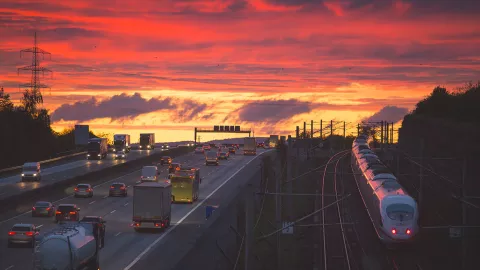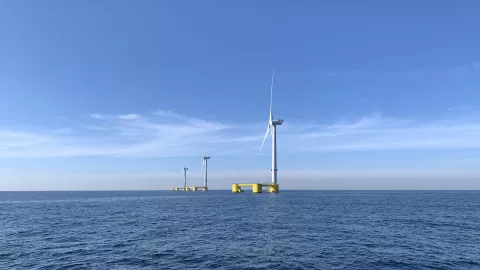The importance of hydrogen for a more sustainable economic development calls for new projects and national and international alliances in all continents. Whether in concrete applications for industry and transport or in the research and development of new solutions, H2 is already one of the drivers of change in Europe and the world.
The European Union as a whole and several individual countries, such as Portugal, recently presented H2 strategies. And the European Alliance for Clean Hydrogen - which brings together more than a thousand companies (including EDP), associations, research centers and other public and private entities - expects an European investment from all involved parties of more than 430 million euros by 2030.
The European Commission's Hydrogen Strategy provides support for the installation of electrolyzers with a total power of 6 GW by 2024 and the production of one million tonnes of green hydrogen. It is still far from being able to provide a good proportion of the world's H2 needs, which are currently at 70 million tons per year, mainly for the oil and chemical industries.
However, from 2025 to 2030, 40 GW of installed power and 10 million tons of green H2 production are expected, and the evolution on the following years will increase. In the 2030 decade, this strategy will focus on the most difficult sectors to decarbonize. This decade will also witness an increasing supply of other H2 needs that are expected to grow, such as transport.
EDP, as a leader in renewable energies, has strengthened its commitment to decarbonization by launching two units that will use the potential of green hydrogen and energy storage systems in Portugal, and worldwide. The newly established H2BU - H2 Business Unit, led by Ana Quelhas, will be the Group's new branch for the development of green hydrogen projects, while the storage-dedicated unit, on EDPR NA, will achieve a 1 GW storage capacity in five years.
Covid-19: More expectations for green H2
In its 2020 report, the International Energy Agency (IEA) outlines a somewhat conservative profile on the global prospects for hydrogen growth. The IEA is concerned about the effect of the Covid-19 pandemic on economies, which has led to a real stop in strategic sectors such as aviation, tourism and trade. In addition, the agency was already noticing a stagnation in global investment in low-emission H2.
However, the same entity sees an open way for green hydrogen, the type of hydrogen with no emissions. The IEA report highlights that the number of projects based on electrolysers was growing, and that this expansion should continue.
In addition to the European Union, several other countries already were, and remain, very focused on hydrogen. The IEA highlights the good examples of Japan, South Korea, the United States, Canada, Germany, France, the Netherlands, Australia or China. Several of these countries have well-defined specific goals for the coming years:
- Japan - 5.3 million domestic micro-units of hydrogen energy production (CHP) sold by 2030; as well as the production and distribution of 300,000 tons of H2 per year. Regarding mobility, Japan expects to have 200,000 hydrogen cell light vehicles in 2025 and 800,000 in 2030, when there will be 1200 buses and 10,000 forklift trucks using that technology too. Regarding the H2 filling stations: these will be 320 in 2025 and 900 in 2030.
- South Korea - 1.5GW of electrical production capacity installed by 2022 and 15GW by 2040 (of which 7GW will be for export and 8GW for domestic use); 50MW of CHP to be used in 2022 and 2,1GW by 2040; production of 470 thousand tons of H2 by 2022, 5.26 million tons by 2040. Regarding mobility, the Korean strategy for 2040 is to have 80,000 taxis, 4,000 buses, 3,000 trucks and 81,000 light-duty vehicles fueled by H2, all powered by 1,200 hydrogen filling stations, 320 of which already in 2022.
- France - 10% of green hydrogen in the total consumed by industry in 2023, which will increase to 20%-40% in 2028. Also 5,000 cars and 200 trucks fueled by H2 in 2023, which are expected to grow to 20,000-50,000 cars and 800-2,000 trucks by 2028; and 400-1000 hydrogen refuelling stations by 2028, 100 of them already in 2023.
- Netherlands - electrolyzers with an accumulated capacity between 500MW to 800MW in 2025, increasing to 3-4GW in 2030. 15,000 cars, 3,000 heavy vehicles and 50 filling stations with H2 in 2025, increasing to 300,000 vehicles fueled by hydrogen in the following five years.
knowledge Sharing
The role of hydrogen in the energy sector
Green hydrogen, with no polluting emissions associated with its use or production, is one of the last stages of a five-century scientific and technological journey. And it is a safe bet towards the global goals of energy efficiency and carbon neutrality.

Ambitious H2 targets also in Portugal
The report by the International Energy Agency does not mention Portugal, but the goals are also rather ambitious. According to the FCH-JU website - an international European public-private initiative to promote hydrogen and fuel cells - in Portugal alone the jobs created by this sector are estimated between 2,500 and 18,450 by 2030.
The Portuguese plan presents two scenarios, and the goals are quite ambitious in the most optimistic estimates:
- 770 electrolysers by 2030, with a total power of 7.45GWh
- 3.64GWh injected into industry
- 900 GWh used in the production of 2.83GWh of electricity
- 109.400 light-duty vehicles fueled by hydrogen (54,700 in the worst case scenario)
- 350 buses, 830 trucks and 5 trains powered by H2
- 196 filling stations supplying hydrogen (100 in the worst scenario)
- 1.8 million tonnes of pollution emissions avoided
António Vidigal, from EDP Inovação, believes that Portugal has the necessary conditions to be a great player. Not only because of the country's renewable energies' potential, but also because of its technological capacity. "Hydrogen is a great opportunity to develop know-how in Portugal," he said, pointing out that some companies "are already beginning to export technology developed in our country. In this sense, this is a great opportunity."
The international dilemma of the hydrogen colors
The growing international focus on hydrogen is indisputable. However, despite the multiplicity of associations and partnerships that exist around the world, the issue of colors also has an impact on different decisions. If some countries - such as Japan, the Netherlands or Portugal - are essentially betting on green hydrogen, others are still very focused on the transition from gray to blue hydrogen, and are more concerned about controlling polluting emissions than about preventing them. But for a truly sustainable future, the path must always be green.



